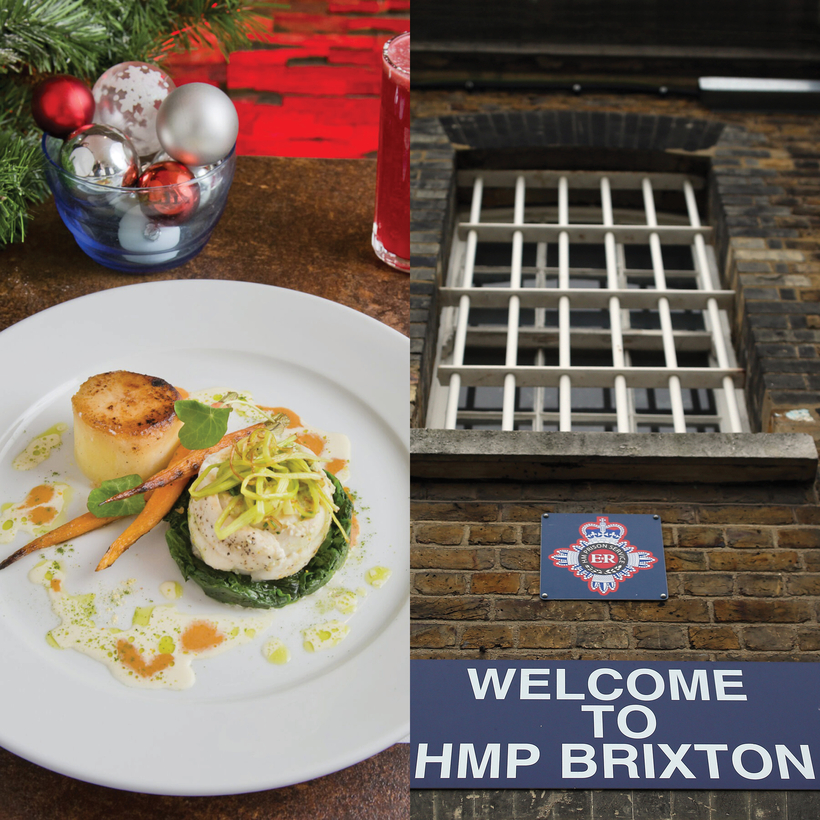I was taking a friend for a birthday lunch in Brixton, one of London’s foodie neighborhoods. I’d booked the table weeks before, handed over a $36 deposit, submitted our dates of birth, and read the extensive rule book, which warned, “Failure to comply can result in security denying you entry.” A bit severe, I thought, but what high-end restaurant doesn’t make you jump through a few hoops?
Upon arrival we presented our passports for inspection and emptied our pockets of phones, chewing gum, and even tissues, in case they had been soaked in narcotics. As we stepped through an airport-style scanner, we were tingling with excited anticipation. It turns out that it’s almost as hard to enter a prison as it is to escape from one.

The Clink is a fine-dining restaurant inside His Majesty’s Prison Brixton, one of London’s oldest, most notorious penitentiaries. Built in 1819, it is located, like many British prisons, behind high walls in a rapidly gentrifying residential area. The Clink is one of a number of rehabilitation projects for offenders still behind bars, and it aims to equip prisoners with hospitality skills in order that they might stay afloat upon release.
In Charles Dickens’s time, Brixton prison was known for its treadmill, a grueling, man-powered machine used for grinding grain. Over the years it has housed I.R.A. terrorists, the Kray gangster twins, the British Fascist leader Sir Oswald Mosley, and even Mick Jagger for a one-night stay in 1967. The treadmill has gone, but the infrastructure and conditions remain decidedly Victorian.

The restaurant is situated in the old prison governor’s house, in a central courtyard surrounded by low buildings topped with razor wire. To the left of the door, a plaque from France’s gastronomic guild La Chaîne des Rôtisseurs stands out amid a welter of notices about door codes and security warnings.
Once you are inside, the décor is blandly elegant. Nobody is wearing stripes. There are 80 covers, and the restaurant can be hired for private events. The only hints that you are in a prison are the plastic cutlery, the absence of alcohol from the menu, and the discreet emergency alarm on the wall.

Our waiter, a serving prisoner in more ways than one, was softly spoken, elaborately tattooed, and polite. However, my first thought, as he handed us the menu, was “What did he do to be here?” Had he stolen my catalytic converter last summer? Or mugged my friend’s son for his phone? Diners are encouraged to talk to the prisoners, but, with only mocktails on offer to loosen inhibitions, I was slightly intimidated to do so.
The Clink charity opened its first public restaurant in 2009, with Lady Edwina Grosvenor, daughter of the sixth Duke of Westminster, as a founding investor. It now runs restaurants in four prisons and has won more than 60 awards, and, according to Tripadvisor, the Brixton Clink is currently ranked in the Top 100 best restaurants in London, far higher than the Ritz Restaurant.

Over a beautifully presented dish of cured sea trout with beluga-lentil-and-beetroot salad, and another of chicken-liver parfait with confit onion brioche and blackberries, my friend and I considered what we were doing there. Were we attracted by the chance to rub up against the rough glamour of lawbreakers? Or were we practicing a rather shameful form of Schadenfreude, peering inside a community that undergoes 23-hour lockdowns before exiting the gates and reveling in our liberty?
One thing was clear: deprived of our phones, we could neither photograph nor post pictures of our food. Instead, perhaps as a way of compensating, my friend chose the main course—a comforting yet sophisticated roast corn-fed chicken with roasted roots, pancetta, and Savoy cabbage—to tell me that her father had spent time in prison when she was a child. Just as I was about to ask her to elaborate, my autumn-squash gnocchi arrived, and, as we both picked at the moreish accompanying sage crisps, the moment passed.

We reflected on what it was about prison that fascinates those on the outside. An acquaintance recently bought a prison door on eBay to keep his children out of his home office. He claims his enthusiasm for it is a boarding-school hangover. My friend has a design-conscious neighbor who boasts of the sleek, lidless, stainless-steel prison toilet he bought at auction. We didn’t know what to make of that.
“We can all in some part of ourselves identify with a prisoner,” suggests Katy Emck, director of Fine Cell Work, another prison charity, which employs prisoners to do embroidery work. “We all long for self-betterment, to be redeemed from our failings. And we love and need stories of hope.”

We were not rushed, but we skipped dessert, despite the offer of blackberry fool and Cornish Yarg cheese. What we didn’t fully understand until the end of our meal was that, rather than observing the prisoners’ world, we were there to offer them an experience of ours. Just by eating at the Clink we had provided an opportunity for the prisoners to practice skills, such as customer service, that are perhaps the hardest thing to teach to people behind bars.
After paying our bill—$78 for two; tipping is discouraged—we obediently bought our souvenir tea towels, picked up our belongings, and made a break for it.
Malika Browne is a London-based writer

